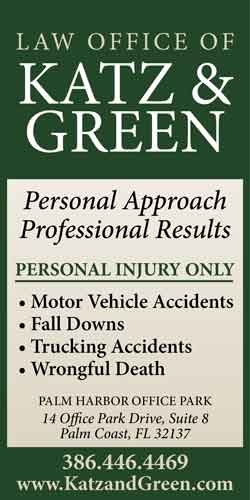
Palm Coast government has filed a motion to dismiss the lawsuit the Flagler Home Builders Association filed against the city in October, arguing that the lawsuit is legally insufficient.
The association is challenging the city’s new schedule of steeply higher development impact fees.
Motions to dismiss are often filed as a first step in response to a civil action. Barring terribly flawed arguments and legal grounding by the party filing the suit, motions to dismiss are just as often denied. But they block out the grounds where the battle will be fought, can at times lead to the partial dismissal of certain counts, or signal where a settlement may take shape.
Absent an outright dismissal, the court will require mediation between the parties regardless. Meanwhile, the new impact fees are in effect.
The Homebuilders Association filed suit on Oct. 1, seeking to halt the city’s new schedule, the one-time levies on builders or developers to help pay for new residents’ “impact” on city services. New residents require new roads, parks and fire trucks. Impact fee revenue helps pay for those expansions.
For example, the parks impact fee alone is $3,164 for a new single-family house in Palm Coast. The fire fee is $942. The school impact fee (levied by the school district) is $5,450, and so on. Impact fees in the city add up to more than $25,000 for a house. It has been a customary and universal means of paying for development in Florida. Revenue sources are limited and elected officials are loath to look to the property tax as a mechanism for growth management, though the property tax is not immune: impact fees are generally not enough to defray the cost of development.
The city raised fire, parks and road impact fees between 73 and 115 percent last July, well above the state limit of 50 percent in a four-year period. Local governments may exceed the 50 percent limit if they show that “extraordinary circumstances” warrant the higher fees. Extraordinary circumstances result from such factors as population surges exceeding the state average and construction costs exceeding the inflation rate.
The suit cited state law, including Senate Bill 180, the newly enacted law that bans local governments from imposing more restrictive or burdensome requirements on developers than those in effect in August 2024.
The suit also charged that the city’s study used to justify higher impact fees was flawed, and that the “extraordinary circumstances” Palm Coast cited to raise impact fees past the ordinary limit imposed by law did not apply to the city.
The heart of Palm Coast’s response in its motion to dismiss is that the Homebuilders Association’s central claims are factually wrong.
For example, while Senate Bill 180’s “restrictive” or “burdensome” language is not defined, the law applies specifically to land development regulations. That means zoning, building construction, sign regulations “or any other regulations controlling the development of land,” Palm Coast’s response states, meaning “the physical use, form, and intensity of development.” (The emphasis is in the city’s response.)
Impact fees don’t fall in that category, the city argues. They’re not land use regulations. They’re financial exactions controlled by a different part of state law. “Impact Fees do not control whether or how land can be developed; they are a condition for the issuance of a building permit to fund the infrastructure necessitated by that development,” Palm Coast’s response states. In simpler terms, impact fees are like taxes, a means of raising revenue to pay for infrastructure growth, as opposed to rules and regulations that manage growth. Both counts 1 and 2 of the lawsuit relate to that part of the argument, and both, in the city’s view, should be dismissed.
The motion was filed by Jeremiah Blocker of the Douglas Law firm, whose attorneys, Marcus Duffy and Blocker, are the regular city attorneys. (Notably this time, the city opted not to contract out its defense to GrayRobinson, the law firm that has handled–and continues to handle–at least three other recent cases, none land use and development related.)
Counts 3 and 4 challenge the city’s facts about where Palm Coast experienced its growth. The association claims the city’s numbers should have been more targeted or “localized” rather than based on citywide counts. But the association’s legal reasoning is “inapplicable,” the city responds, with Blocker essentially suggesting that the association cherry-picked cases to support its argument, even though in one case the association cites, the challenge to impact fees was successful. (The challenge was to school impact fees, which Blocker also finds inapplicable in Palm Coast.)
As for extraordinary circumstances, it comes down to the association saying they did not exist, and Palm Coast saying they did, though both stances are based on demonstrable facts: both sets cannot be equally true. It would be up to a judge to determine the facts’ validity.
Plaintiffs include the association, five local homebuilders and a local resident. The case is before Circuit Judge Sandra Upchurch, and has not been scheduled for a hearing yet. Chief Judge Leah Case has ordered that the trial date be no later than 18 months from the time of filing.
![]()




























Greg says
I find this action quite unreal. The association that has controlled the city’s decisions are now suing the city. I find it quite amazing and humorous.
Dennis C Rathsam says
Yet another mess here in the biggest parking lot in Fl! We need to vote for folks, who have the best interests of P/C. Every day, another problem pops up!!!! The right hand, has no idea what the left hand is doing. And Neiter hand cares!
Ben says
Palm Coast City may be right, but they are not acting wisely.
They claim these extraordinary changes began in recent years due to inflation and rising construction costs, which means it was well known and not a surprise. Instead of announcing a roadmap for the next one to two years, they immediately raised the bar dramatically, leaving no time to plan or adjust business plans.
This decision was not made in a vacuum, and everyone, especially in Florida, is aware that home prices are declining and builders’ profits are shrinking. This sudden decision with zero preparation time is just another, if not the final, hit to the industry.
One can only wonder about the timing. 🤔